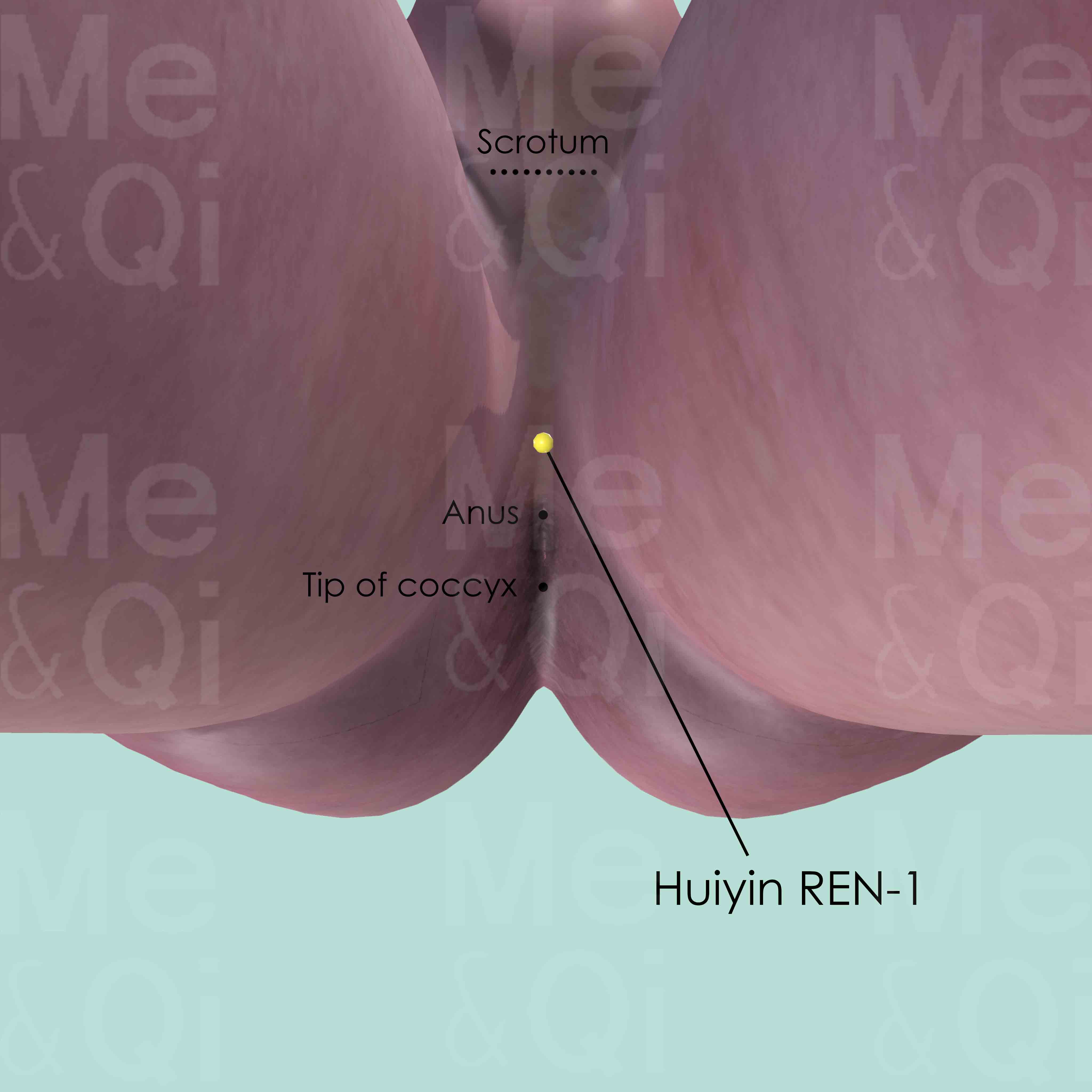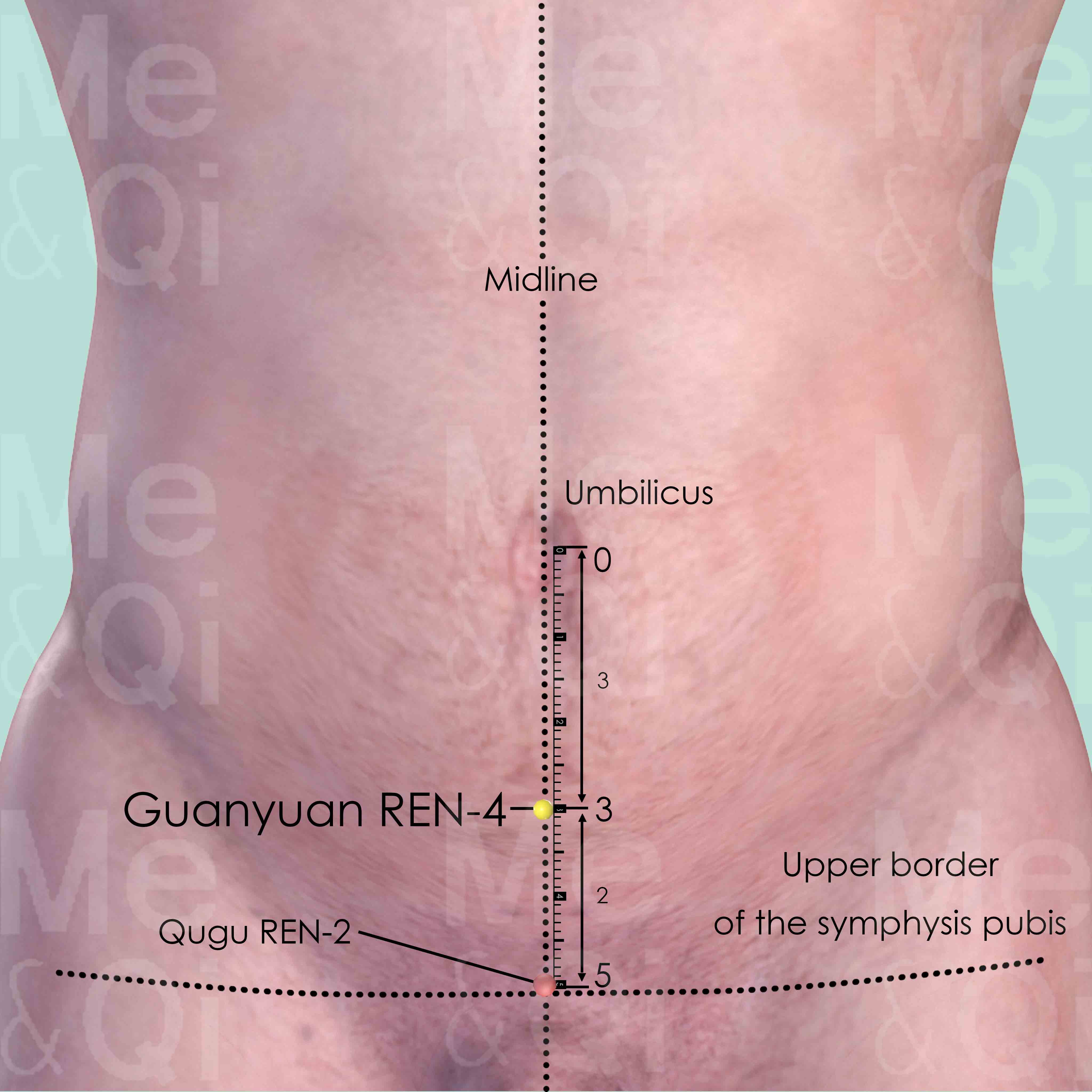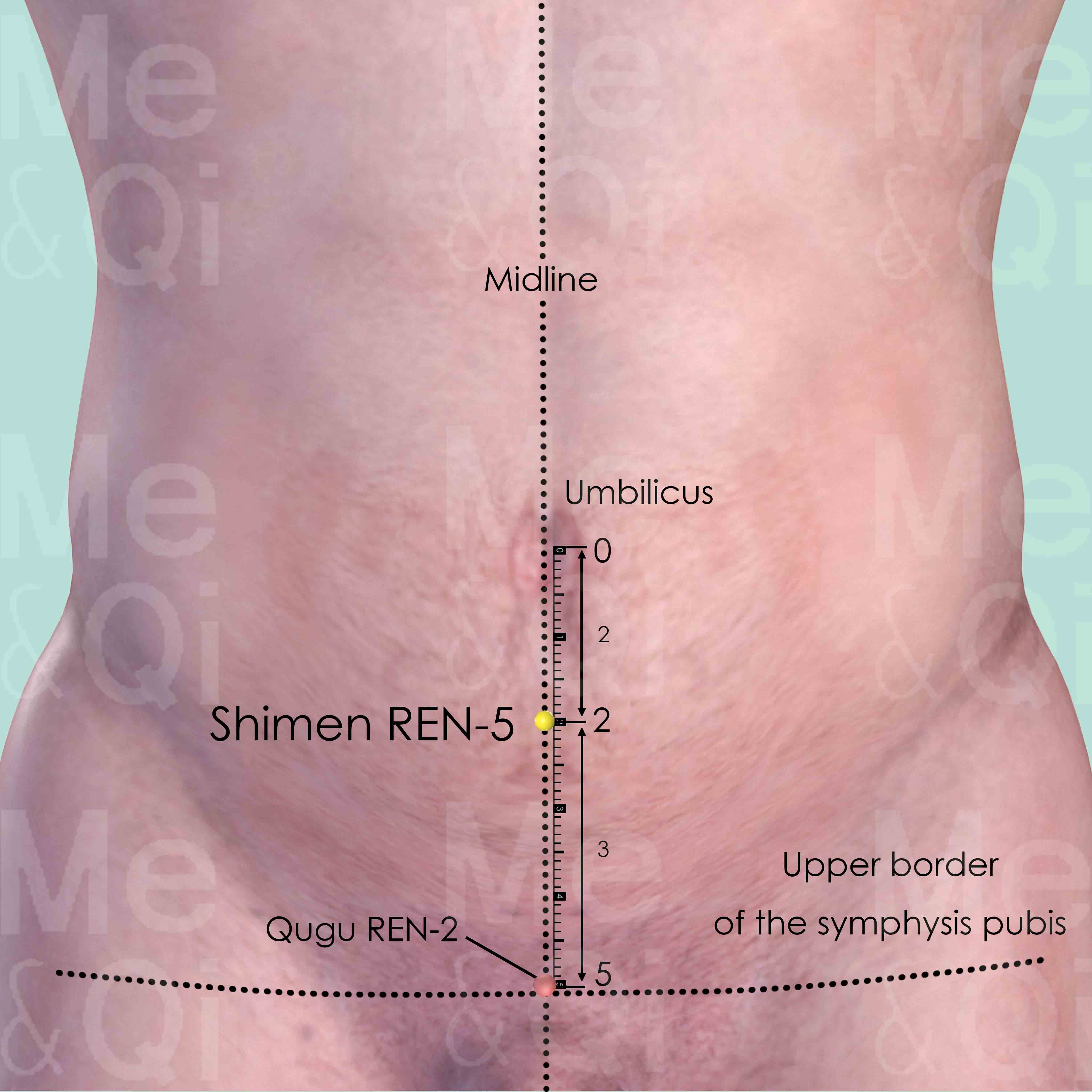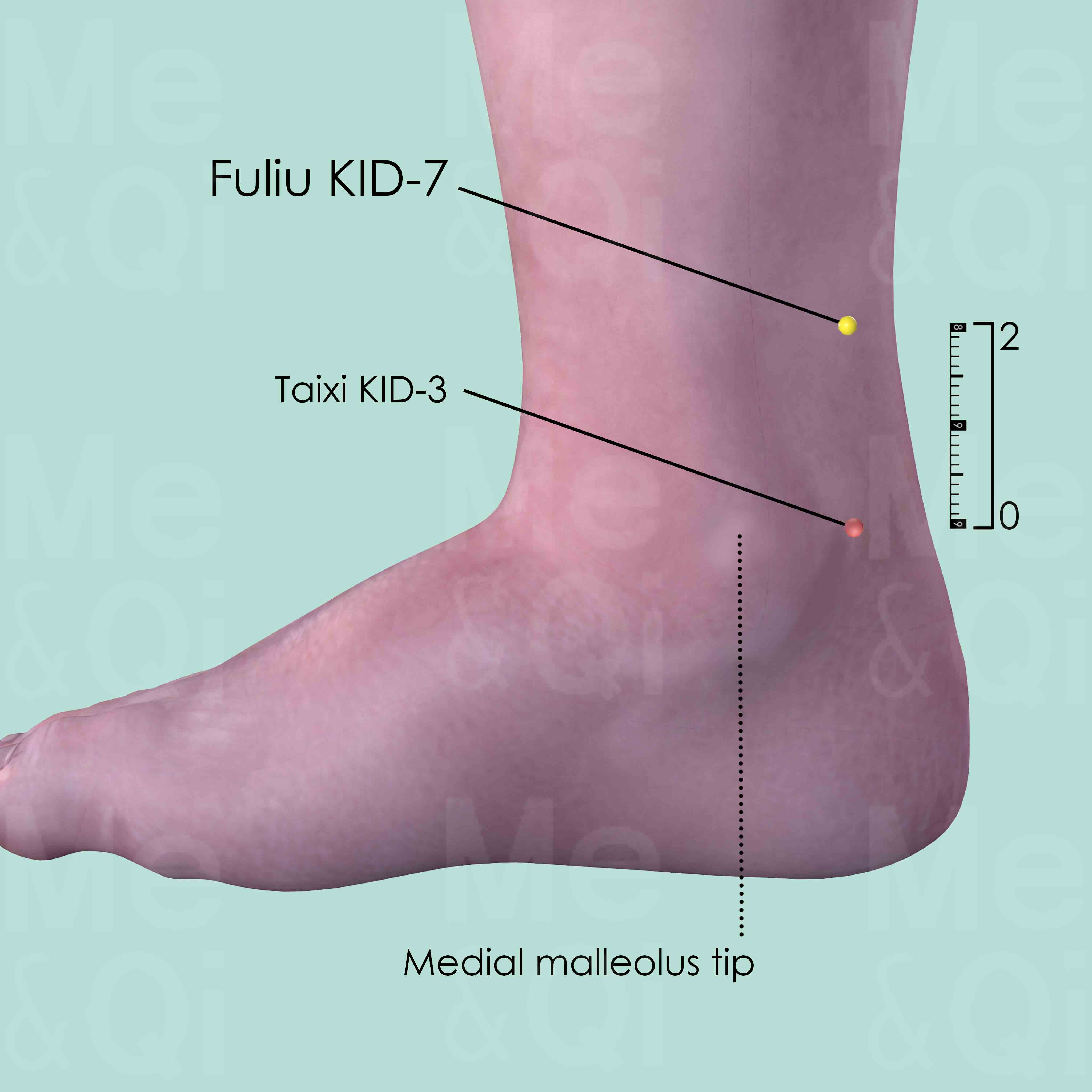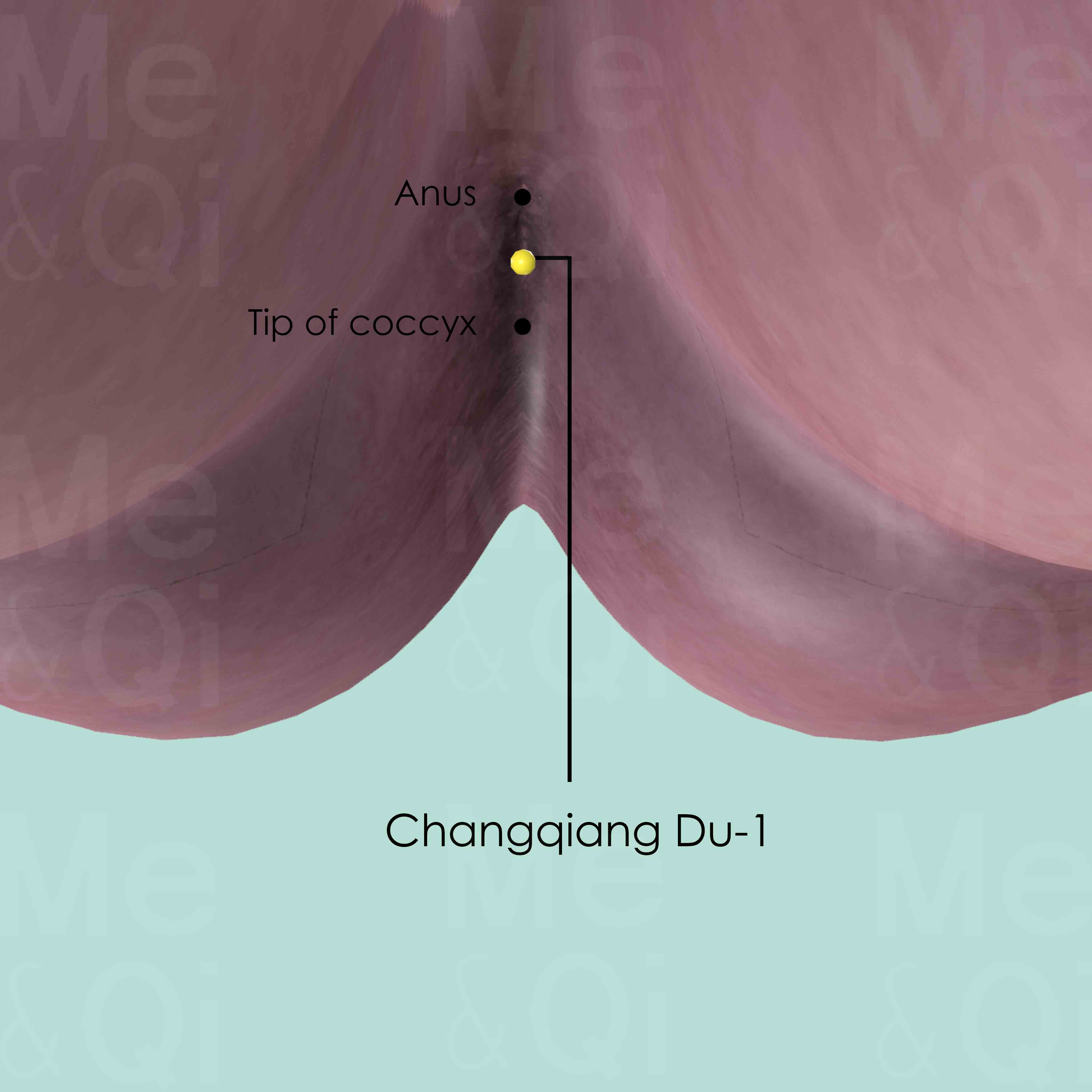Painful Urinationaccording to TCM
Symptom family: Urinary pain and discomfort
What is Painful Urination?
Painful urination, medically termed dysuria, is a discomfort or burning sensation during urination. It is not a condition in itself but rather a symptom that can stem from various underlying issues, ranging from urinary tract infections to inflammation of the urethra. For many, it's a telltale sign alerting to disturbances in the urinary system.
How Does TCM View Painful Urination?
In the realm of Traditional Chinese Medicine (TCM), painful urination is often seen as a manifestation of an underlying disharmony within the body's energetic system. According to TCM, the root of this symptom can often be traced to imbalances in the body’s Qi (vital energy), with specific patterns of disharmony leading to pain.
The recognition and identification of the precise pattern are critical because they dictate the treatment strategy in TCM. This holistic approach underscores the importance of restoring balance and harmony to the body as a whole rather than merely addressing the symptom.
Root Causes of Painful Urination in TCM
TCM recognizes several patterns that can lead to painful urination, each with its unique set of associated symptoms. Damp-Heat in the Lower Burner is a common pattern characterized by symptoms such as a burning sensation during urination, yellowish and possibly scanty urine, and a sensation of heat.
Another pattern might involve Qi Deficiency, where the body’s vital energy is weakened, leading to a lack of control and function of the bladder and causing painful urination. In treating these imbalances, a TCM practitioner would select treatment strategies tailored to address the specific disharmonies present in the individual.
Explore below more details about what might cause Painful urination according to TCM.
- By Syndrome
- By Organ
- Heat
- Qi Deficiency
- Qi Stagnation
- Dampness
- View More Causes
- Liver
- Spleen
- Gallbladder
Heat
In TCM "Heat" signifies an excess of Yang energy, leading to an imbalance where heat predominates over the body's cool Yin aspects. This condition is metaphorically akin to an internal over-heating. Symptoms indicative of Heat can include feelings of warmth, fever, sweating, irritability, red face, thirst with a preference for cold drinks, and a rapid pulse. The tongue may appear red with a yellow coating. Unlike the common interpretation of heat in terms of temperature, in TCM, it represents a state of hyperactivity or inflammation in the body.... see more
Heat Patterns That Can Lead to Painful Urination
Common Symptoms: Dry Mouth Irritability Scanty And Yellow Urine Lower Back Pain Weakness Of Lower Extremities Red And Swollen Feet Swollen Knee Thick Greasy Vaginal Secretions
| Pattern Name | Relevant Symptoms | Relevant Formulas |
|---|---|---|
| Damp-Heat in the Lower Burner | Painful urination, Scanty and yellow urine, Lower back pain, Weakness of lower extremities, Red and swollen feet, Swollen knee, Thick greasy vaginal secretions, Ulcers on the lower limbs, Scanty and dark urine, Dry mouth, Dry throat... see more | Ba Zheng San |
| Liver Qi Stagnation with Spleen Qi Deficiency that transforms into Heat | Painful urination, Irritability, Spontaneous sweat, Eye hyperemia, Dry mouth, Palpitations, Lower abdominal oppression, Excessive menstruation, Abnormal uterine bleeding, Tidal fever, Infertility... see more | Jia Wei Xiao Yao San |
| Heat Excess in the Liver or Gallbladder | Painful urination, Hypochondriac pain, Headaches, Dizziness, Red and irritated eyes, Hearing loss, Ear swelling, Bitter taste in the mouth, Irritability, Swollen and itchy external genitalia, Foul-Smelling vaginal discharge... see more | Long Dan Xie Gan Tang |
Qi Deficiency
Qi Deficiency in TCM is like running low on battery power. Qi is the vital energy that powers every function in your body. When there's a Qi Deficiency, it means your body doesn't have enough of this essential energy. This can make you feel tired all the time, weak, or even cause shortness of breath. It's similar to how you feel when you haven't had enough sleep or nutritious food. Your body just doesn't have the energy it needs to perform at its best. Unlike modern medicine, which often focuses on specific physical causes for fatigue and weakness, TCM views Qi Deficiency as an overall energy depletion that affects your entire well-being, and it seeks to replenish and balance this vital energy.... see more
Qi Deficiency Patterns That Can Lead to Painful Urination
| Pattern Name | Relevant Symptoms | Relevant Formulas |
|---|---|---|
| Liver Qi Stagnation with Spleen Qi Deficiency that transforms into Heat | Painful urination, Irritability, Spontaneous sweat, Eye hyperemia, Dry mouth, Palpitations, Lower abdominal oppression, Excessive menstruation, Abnormal uterine bleeding, Tidal fever, Infertility... see more | Jia Wei Xiao Yao San |
Qi Stagnation
Qi Stagnation in TCM is like having a traffic jam in your body's energy system. Qi, the vital life force that flows through your body, is supposed to move smoothly to maintain health and balance. But with Qi Stagnation, this flow gets blocked or slowed down, like cars stuck on a highway. This can lead to symptoms like feeling stressed, emotional mood swings, and physical discomfort, often described as a feeling of fullness or tightness, especially in the chest or abdomen. It's as though the body's internal energy circulation is disrupted, causing various issues. TCM sees this as an energy flow problem, different from modern medicine's focus on specific physiological processes.... see more
Qi Stagnation Patterns That Can Lead to Painful Urination
| Pattern Name | Relevant Symptoms | Relevant Formulas |
|---|---|---|
| Liver Qi Stagnation with Spleen Qi Deficiency that transforms into Heat | Painful urination, Irritability, Spontaneous sweat, Eye hyperemia, Dry mouth, Palpitations, Lower abdominal oppression, Excessive menstruation, Abnormal uterine bleeding, Tidal fever, Infertility... see more | Jia Wei Xiao Yao San |
Dampness
"Dampness" in TCM is a concept that describes a pattern of disharmony where the body accumulates excess moisture. Imagine the heavy, sticky feeling you get on a very humid day; that's similar to what dampness feels like internally. It can manifest as a sense of heaviness, bloating, sluggishness, or even a foggy mind. This condition is often thought to arise from environmental factors like living in a damp place, dietary habits that promote moisture in the body, or internal imbalances that hinder the body's ability to process fluids properly. In TCM, dampness can obstruct the normal flow of energy and fluids in the body, leading to various symptoms.... see more
Dampness Patterns That Can Lead to Painful Urination
| Pattern Name | Relevant Symptoms | Relevant Formulas |
|---|---|---|
| Damp-Heat in the Lower Burner | Painful urination, Scanty and yellow urine, Lower back pain, Weakness of lower extremities, Red and swollen feet, Swollen knee, Thick greasy vaginal secretions, Ulcers on the lower limbs, Scanty and dark urine, Dry mouth, Dry throat... see more | Ba Zheng San |
Liver
In TCM the Liver is viewed as the organ responsible for the smooth flow of Qi, Blood, and emotions throughout the body. It plays a key role in regulating mood, storing blood, supporting digestion, and ensuring the health of tendons and eyes. When the Liver malfunctions or is imbalanced in TCM, it can lead to a range of issues such as irritability, mood swings, menstrual irregularities, eye problems, and muscular stiffness or pain. A malfunctioning Liver in TCM reflects not only physical disturbances but also emotional and mental disharmony, emphasizing the holistic approach of TCM in addressing health and wellness.... see more
Liver Patterns That Can Lead to Painful Urination
Common Symptoms: Irritability Spontaneous Sweat Eye Hyperemia Dry Mouth Palpitations Lower Abdominal Oppression Excessive Menstruation Abnormal Uterine Bleeding
| Pattern Name | Relevant Symptoms | Relevant Formulas |
|---|---|---|
| Liver Qi Stagnation with Spleen Qi Deficiency that transforms into Heat | Painful urination, Irritability, Spontaneous sweat, Eye hyperemia, Dry mouth, Palpitations, Lower abdominal oppression, Excessive menstruation, Abnormal uterine bleeding, Tidal fever, Infertility... see more | Jia Wei Xiao Yao San |
| Heat Excess in the Liver or Gallbladder | Painful urination, Hypochondriac pain, Headaches, Dizziness, Red and irritated eyes, Hearing loss, Ear swelling, Bitter taste in the mouth, Irritability, Swollen and itchy external genitalia, Foul-Smelling vaginal discharge... see more | Long Dan Xie Gan Tang |
Spleen
In TCM the Spleen plays a vital role in digestion and transformation, converting food into energy and nutrients, and overseeing the distribution of Qi and Blood. It's also crucial in maintaining the health of muscles and limbs and ensuring the blood remains within the vessels. When the Spleen malfunctions in TCM, it can lead to a variety of issues such as digestive disorders, fatigue, weak muscles, bloating, and a feeling of heaviness. It can also cause a pale complexion, poor appetite, and a tendency to bruise easily. Emotionally, a Spleen imbalance is often associated with excessive worry or overthinking, reflecting its role in the interplay between physical and mental health.... see more
Spleen Patterns That Can Lead to Painful Urination
| Pattern Name | Relevant Symptoms | Relevant Formulas |
|---|---|---|
| Liver Qi Stagnation with Spleen Qi Deficiency that transforms into Heat | Painful urination, Irritability, Spontaneous sweat, Eye hyperemia, Dry mouth, Palpitations, Lower abdominal oppression, Excessive menstruation, Abnormal uterine bleeding, Tidal fever, Infertility... see more | Jia Wei Xiao Yao San |
Gallbladder
In TCM the Gallbladder has a unique role in storing and excreting bile, but more importantly, it's seen as crucial for decision-making and courage. It's closely connected to the Liver, assisting in the smooth flow of Qi (vital energy) and supporting the Liver's role in maintaining emotional balance. When the Gallbladder malfunctions or is imbalanced in TCM, it can lead to physical symptoms like gallstones, jaundice, or a bitter taste in the mouth. There might also be digestive disturbances, particularly related to fat metabolism. On an emotional level, a Gallbladder disorder can manifest as indecisiveness, timidity, or a tendency to easily succumb to stress. These symptoms highlight the TCM view of the Gallbladder as integral to both physical processes and emotional resilience.... see more
Gallbladder Patterns That Can Lead to Painful Urination
| Pattern Name | Relevant Symptoms | Relevant Formulas |
|---|---|---|
| Heat Excess in the Liver or Gallbladder | Painful urination, Hypochondriac pain, Headaches, Dizziness, Red and irritated eyes, Hearing loss, Ear swelling, Bitter taste in the mouth, Irritability, Swollen and itchy external genitalia, Foul-Smelling vaginal discharge... see more | Long Dan Xie Gan Tang |
TCM Herbal Formulas for Painful Urination
For the treatment of painful urination, TCM turns to a pharmacopeia of herbs and formulas designed to target the underlying patterns. For Damp-Heat in the Lower Burner, Ba Zheng San is a classic formula that uses Chinese Pink Herbs (Qu Mai) to drain Dampness and clear Heat, alleviating pain.
In cases of Qi Deficiency, tonic herbs and formulas that strengthen the Qi may be employed to restore the body's vital energy and improve bladder function.
Explore below some TCM herbal formulas used to address painful urination, organized by cause and by formula type.
- By Cause
- By Formula Type
- Heat
- Qi Deficiency
- Qi Stagnation
- Dampness
- View More Causes
- Formulas that clear heat and expel dampness
- Formulas that warm and transform water and dampness
- Formulas that harmonize liver-Spleen
- Formulas that clear heat from the organs
Top Formula for Heat:
Ba Zheng San
Suitable for Heat patterns that may cause painful urination, such as Damp-Heat in the Lower Burner
Learn moreAll Formulas Recommended for Painful Urination Caused by Heat
| Formula | Patterns Suitable For |
|---|---|
| Ba Zheng San | Damp-Heat in the Lower Burner |
| Jia Wei Xiao Yao San | Liver Qi Stagnation with Spleen Qi Deficiency that transforms into Heat |
| Long Dan Xie Gan Tang | Heat Excess in the Liver or Gallbladder |
Top Formula for Qi Deficiency:
Jia Wei Xiao Yao San
Suitable for Qi Deficiency patterns that may cause painful urination, such as Liver Qi Stagnation with Spleen Qi Deficiency that transforms into Heat
Learn moreTop Formula for Qi Stagnation:
Jia Wei Xiao Yao San
Suitable for Qi Stagnation patterns that may cause painful urination, such as Liver Qi Stagnation with Spleen Qi Deficiency that transforms into Heat
Learn moreTop Formula for Dampness:
Ba Zheng San
Suitable for Dampness patterns that may cause painful urination, such as Damp-Heat in the Lower Burner
Learn moreFormulas that clear Heat and expel dampness
These formulas are suitable for some painful urination-causing patterns like Damp-Heat in the Lower Burner.
One such formula is Ba Zheng San, with chinese pink herb as a key herb.
Formulas that harmonize Liver-Spleen
These formulas are suitable for some painful urination-causing patterns like Liver Qi Stagnation with Spleen Qi Deficiency that transforms into Heat.
One such formula is Jia Wei Xiao Yao San, with bupleurum root as a key herb.
Formulas that clear Heat from the Organs
These formulas are suitable for some painful urination-causing patterns like Heat Excess in the Liver or Gallbladder.
One such formula is Long Dan Xie Gan Tang, with chinese gentian as a key herb.
Formulas that warm and transform water and Dampness
Painful urination can be treated by these formulas if it is due to cold-dampness obstructing the body's functions, requiring warming and damp-transforming actions.
One such formula is Bi Xie Fen Qing Yin, with fish-poison yam as a key herb.
Acupoints for Painful Urination
TCM also incorporates acupuncture as a method to alleviate painful urination. Specific acupoints, such as Ciliao BL-32 and Sanyinjiao SP-6, are selected for their ability to regulate the Lower Burner, resolve Dampness, and restore the proper flow of Qi through the urinary tract. By stimulating these points, a TCM practitioner aims to relieve pain and correct the underlying disharmony causing the symptom.
Explore below some acupoints used to address painful urination, organized by meridian.
- By Meridian
- Bladder Channel
- Directing Vessel
- Spleen Channel
- Liver Channel
- Kidney Channel
- Governing Vessel
- Lung Channel
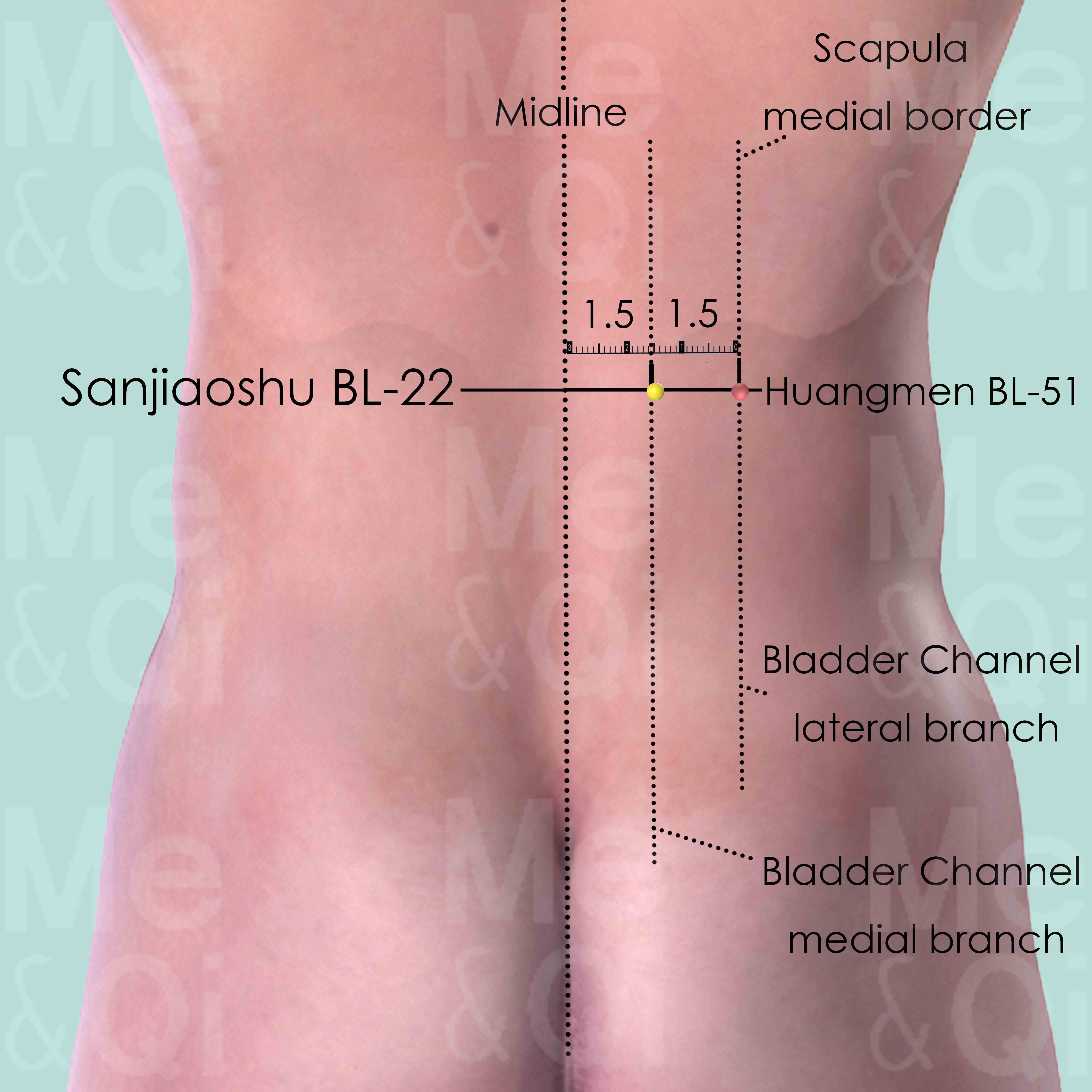
Sanjiaoshu BL-22
1.5 cun lateral to the lower border of the spinous process of the 1st lumbar vertebra.
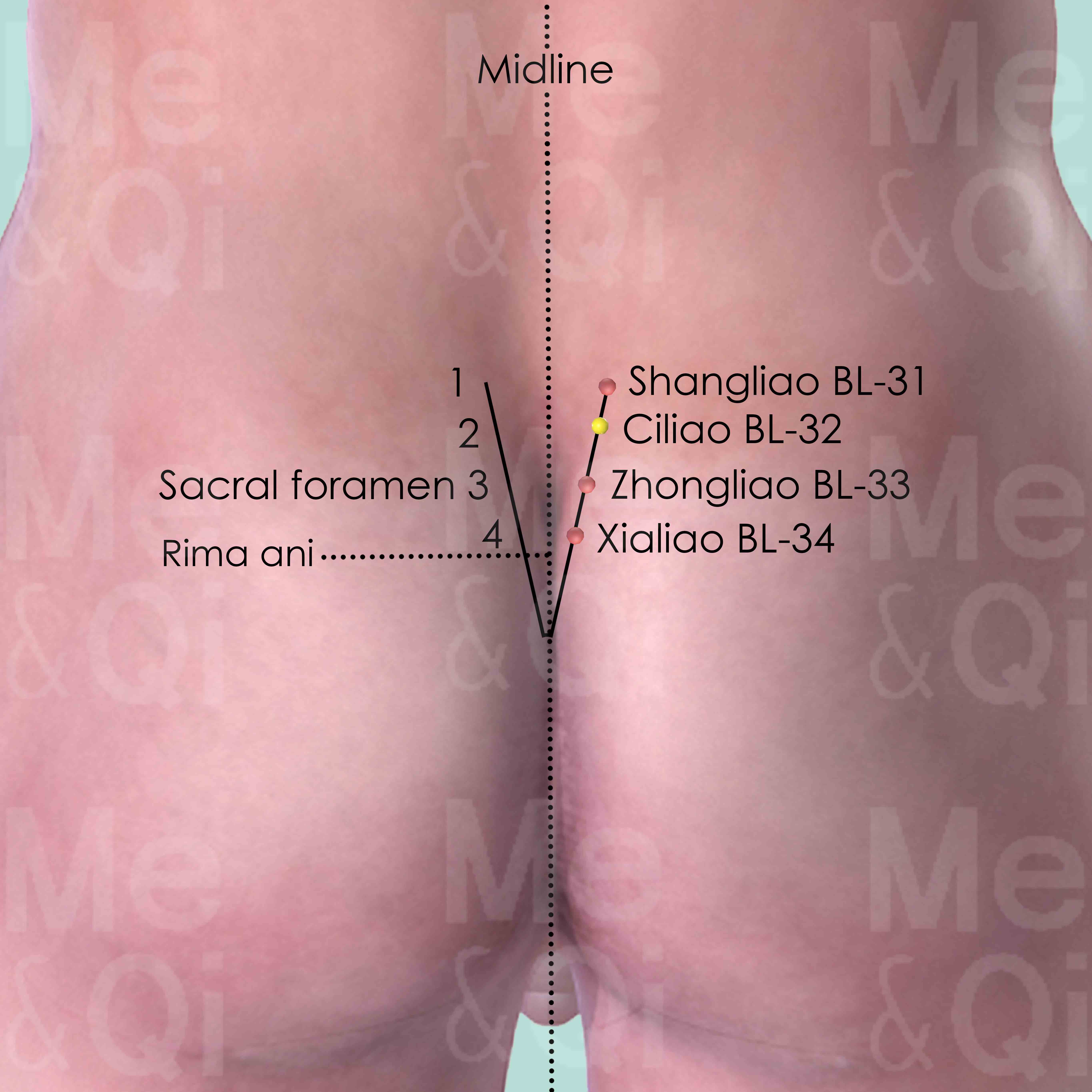
Ciliao BL-32
In the 2nd posterior sacral foramen, about midway between the posterior superior iliac spine (PSIS) and the midline.
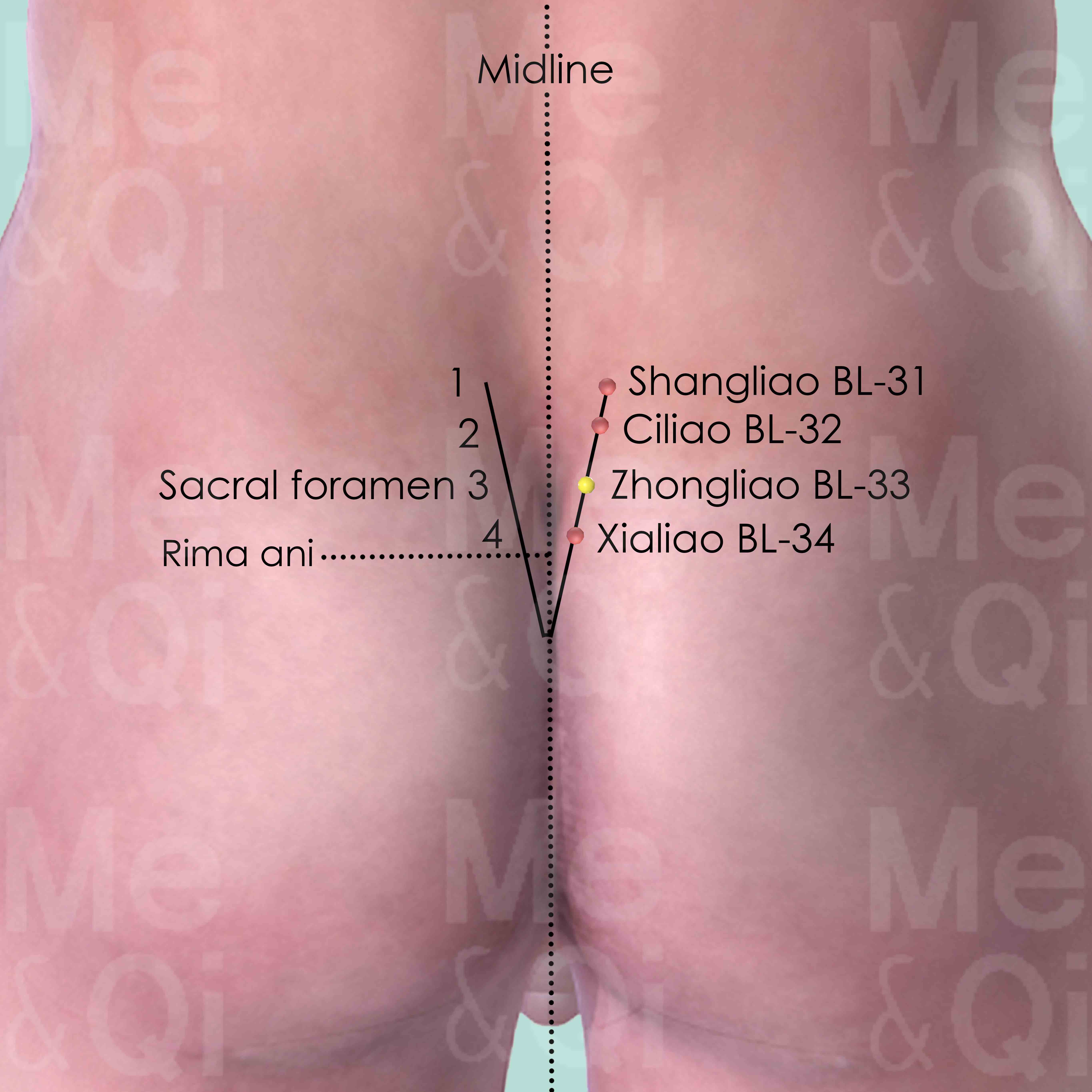
Zhongliao BL-33
In the 3rd posterior sacral foramen, between the posterior superior iliac spine and the midline.
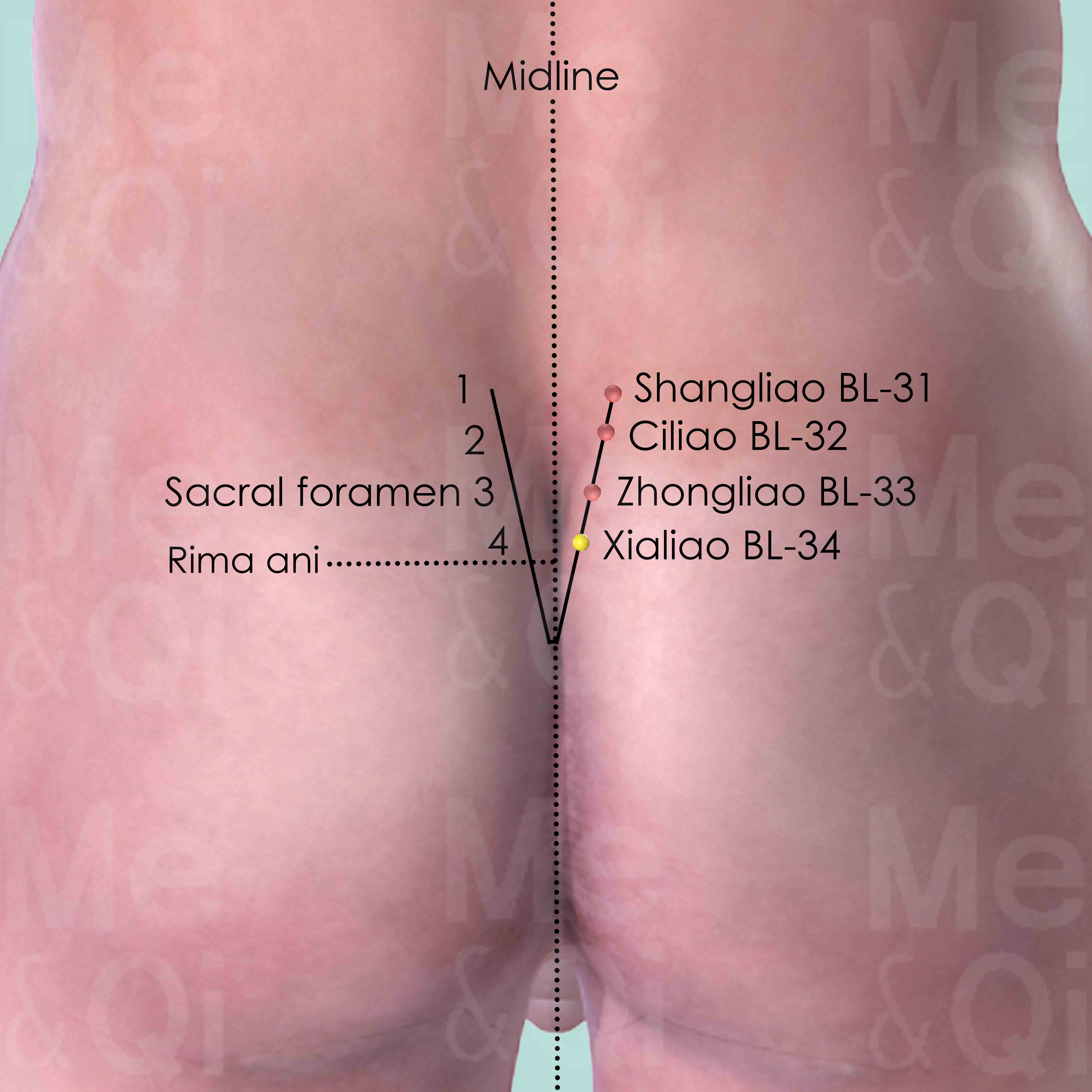
Xialiao BL-34
In the 4th posterior sacral foramen, between the posterior superior iliac spine and the midline.
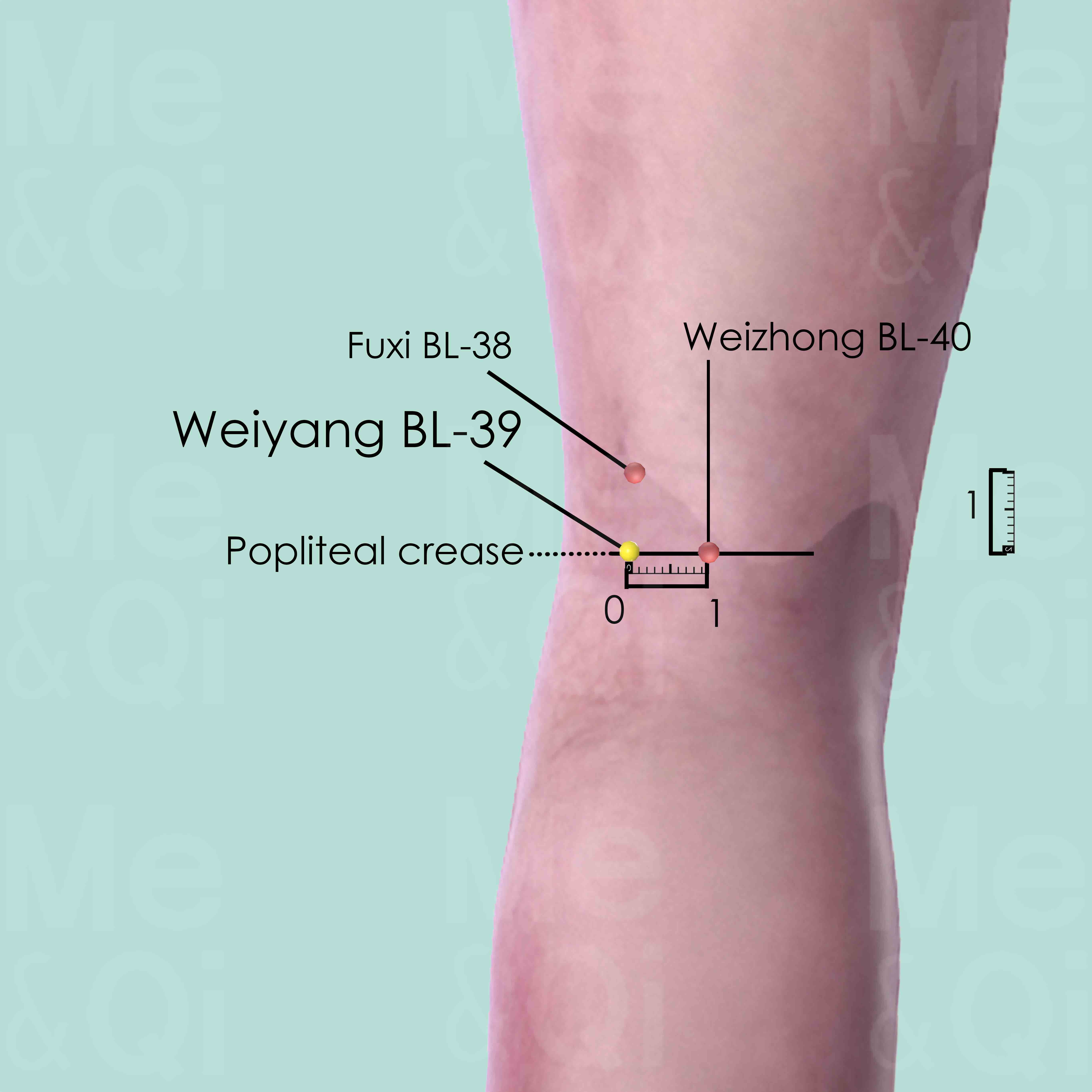
Weiyang BL-39
At the lateral end of the popliteal crease, on the medial border of the tendon of biceps femoris muscle, 1 cun lateral to Weizhong BL-40 which is the midpoint of the popliteal crease. It is also 1 cun below Fuxi BL-38.
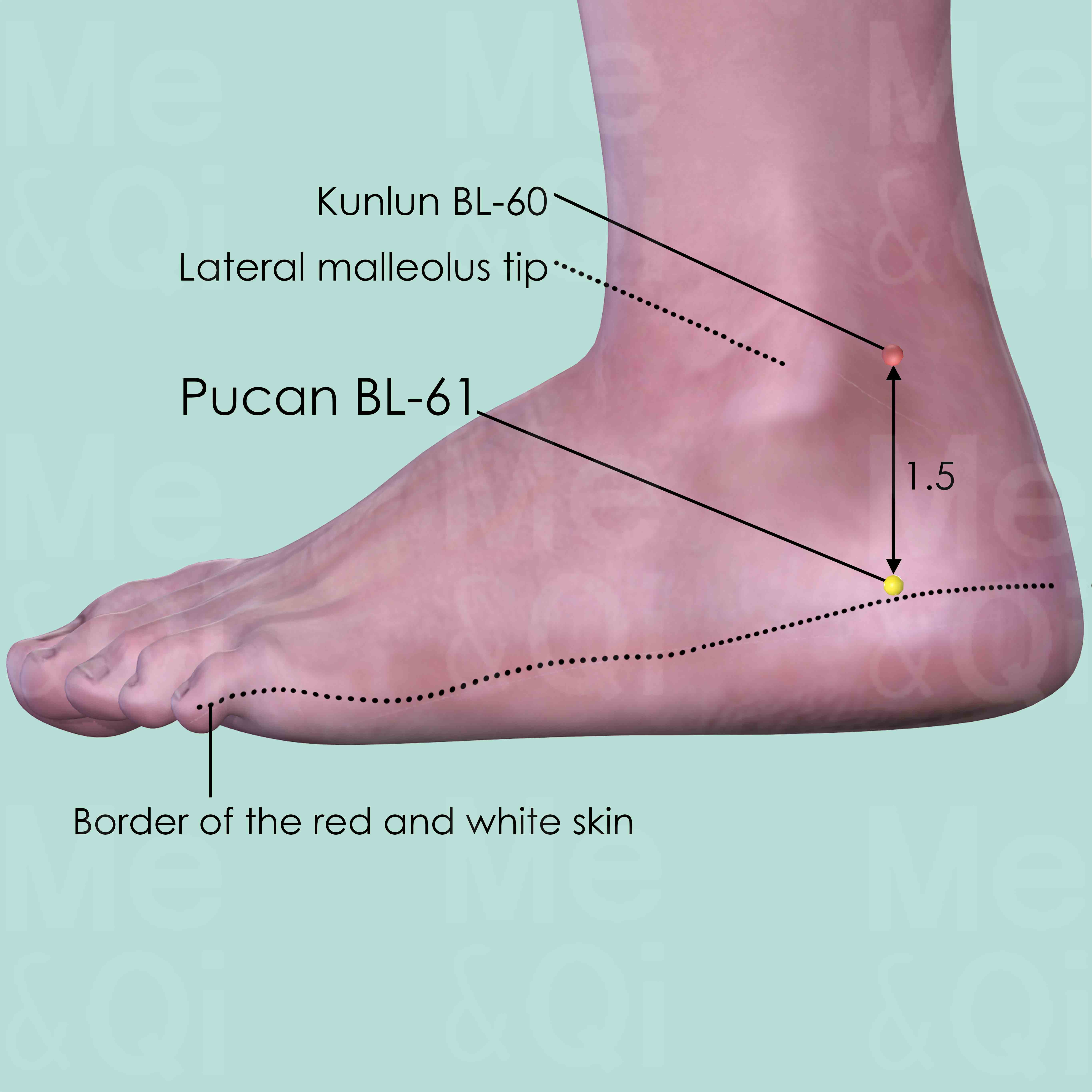
Pucan BL-61
Posterior and inferior to the external malleolus, directly below Kunlun BL-60, in the depression of the calcaneum at the junction of the red and white skin.
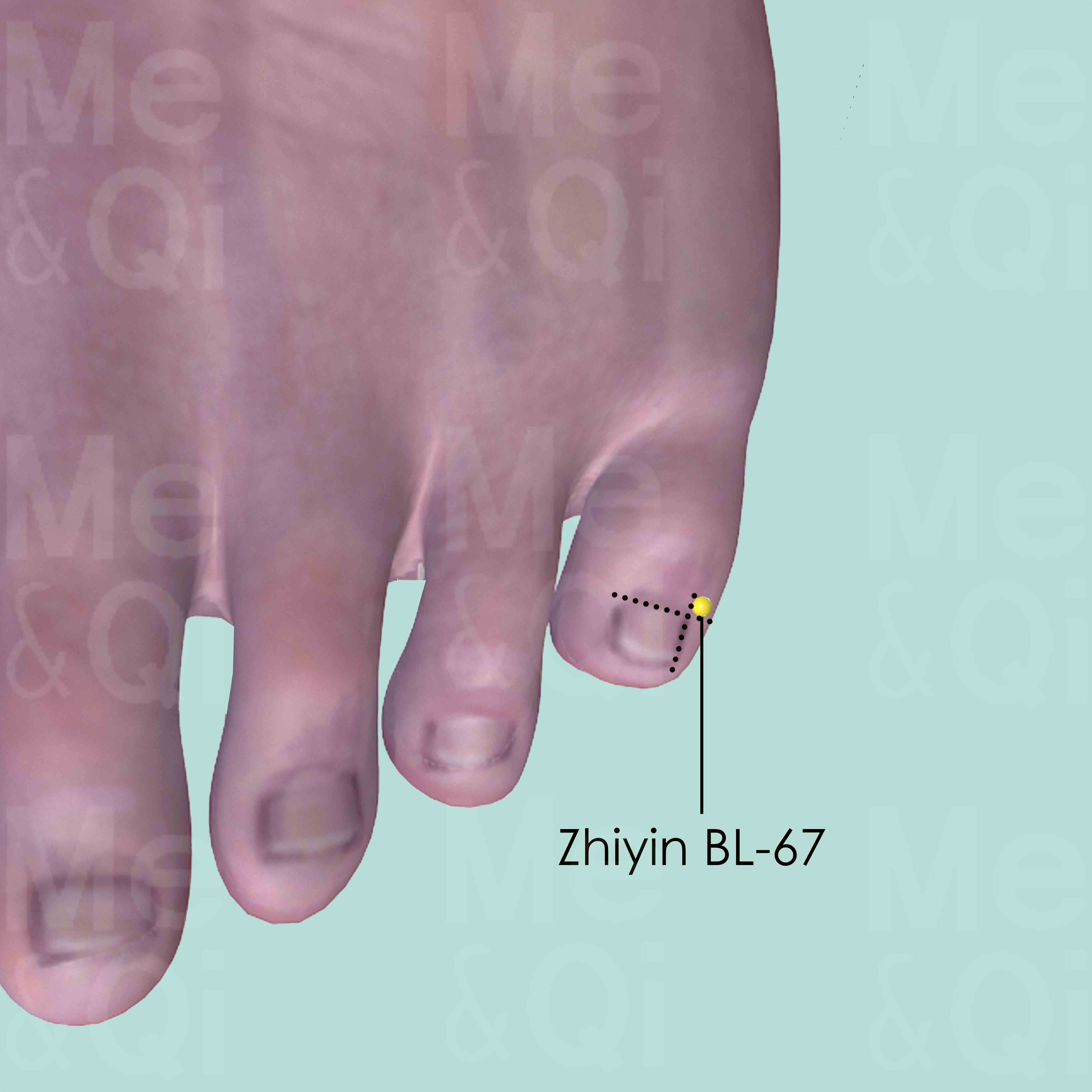
Zhiyin BL-67
On the lateral side of the little toe, about 0.1 cun posterior to the corner of the nail.
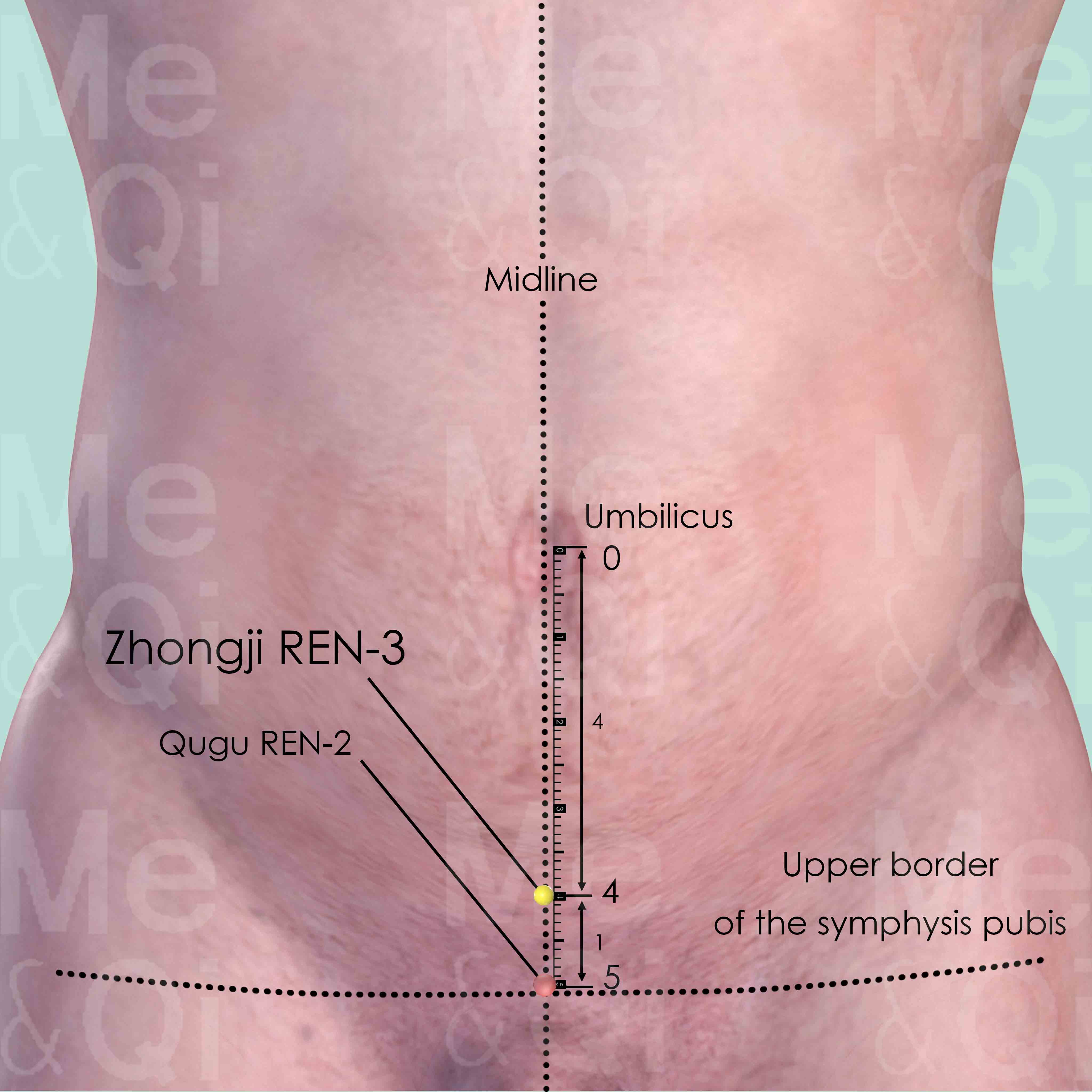
Zhongji REN-3
On the anterior midline, 4 cun below the umbilicus, 1 cun above Qugu REN-2, which is located at the upper border of the symphysis pubis.
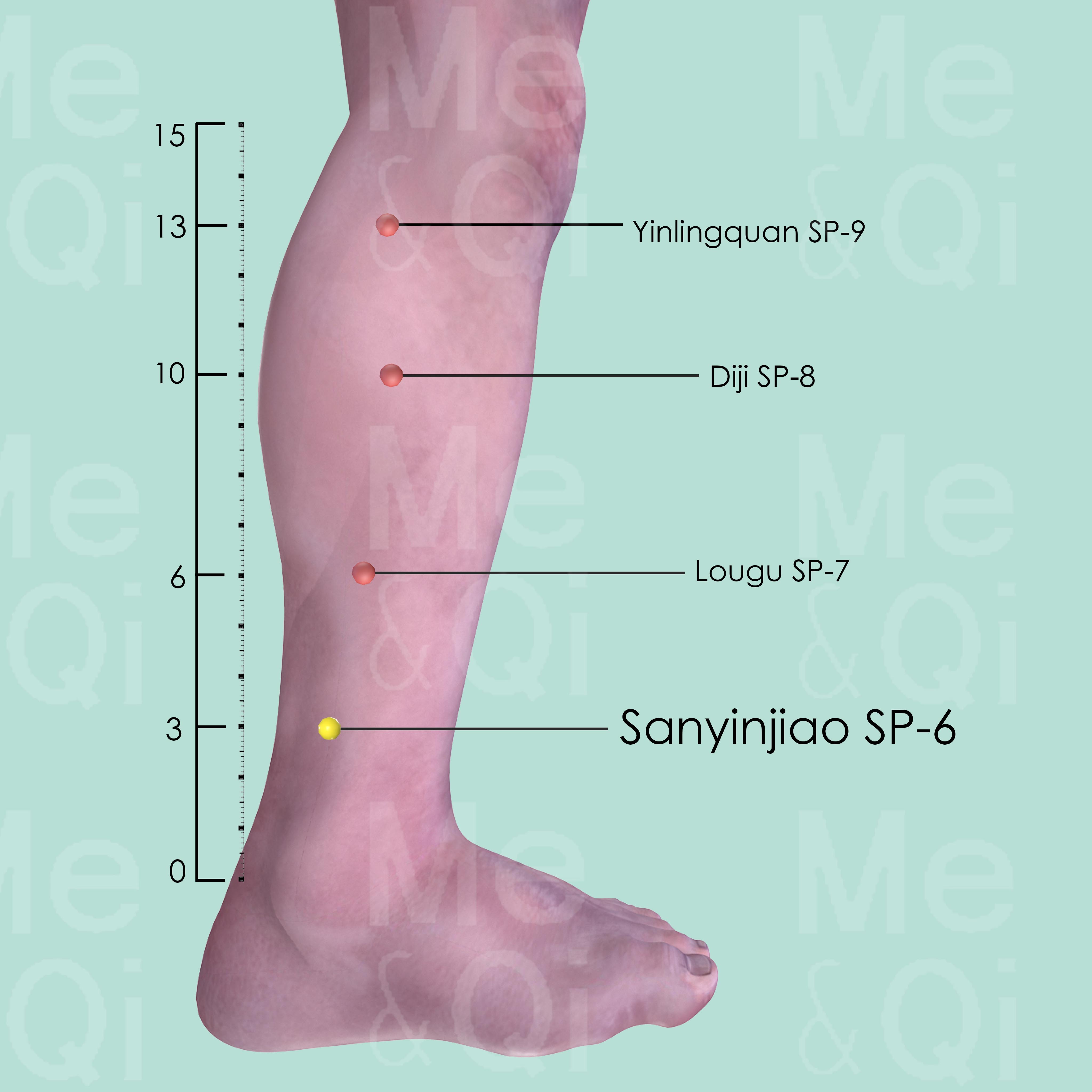
Sanyinjiao SP-6
3 cun directly above the tip of the medial malleolus, on the posterior border of the tibia, on the line drawn from the medial malleolus to Yinlingquan SP-9.
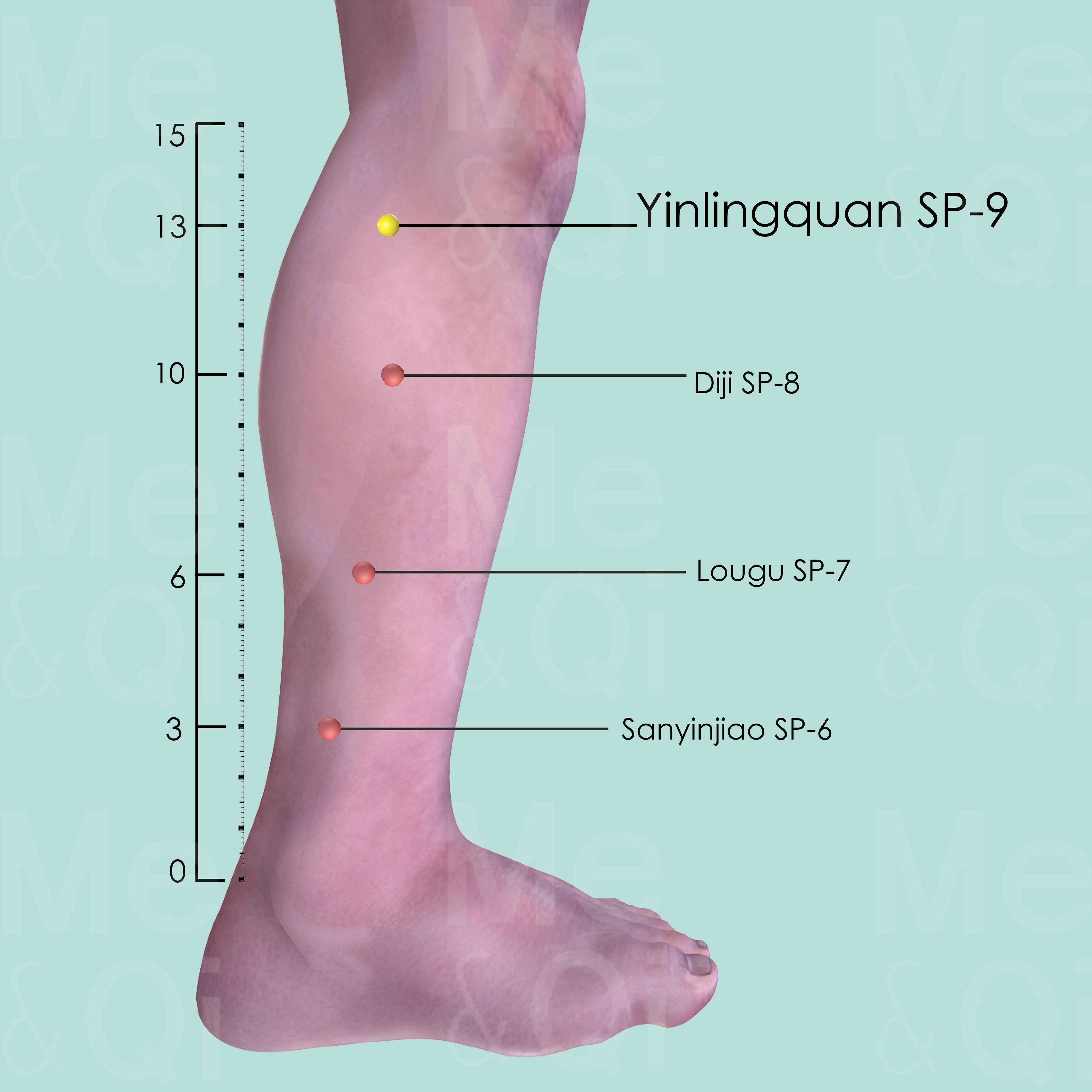
Yinlingquan SP-9
On the lower border of the medial condyle of the tibia, in the depression between the posterior border of the tibia and gastrocnemius muscle.
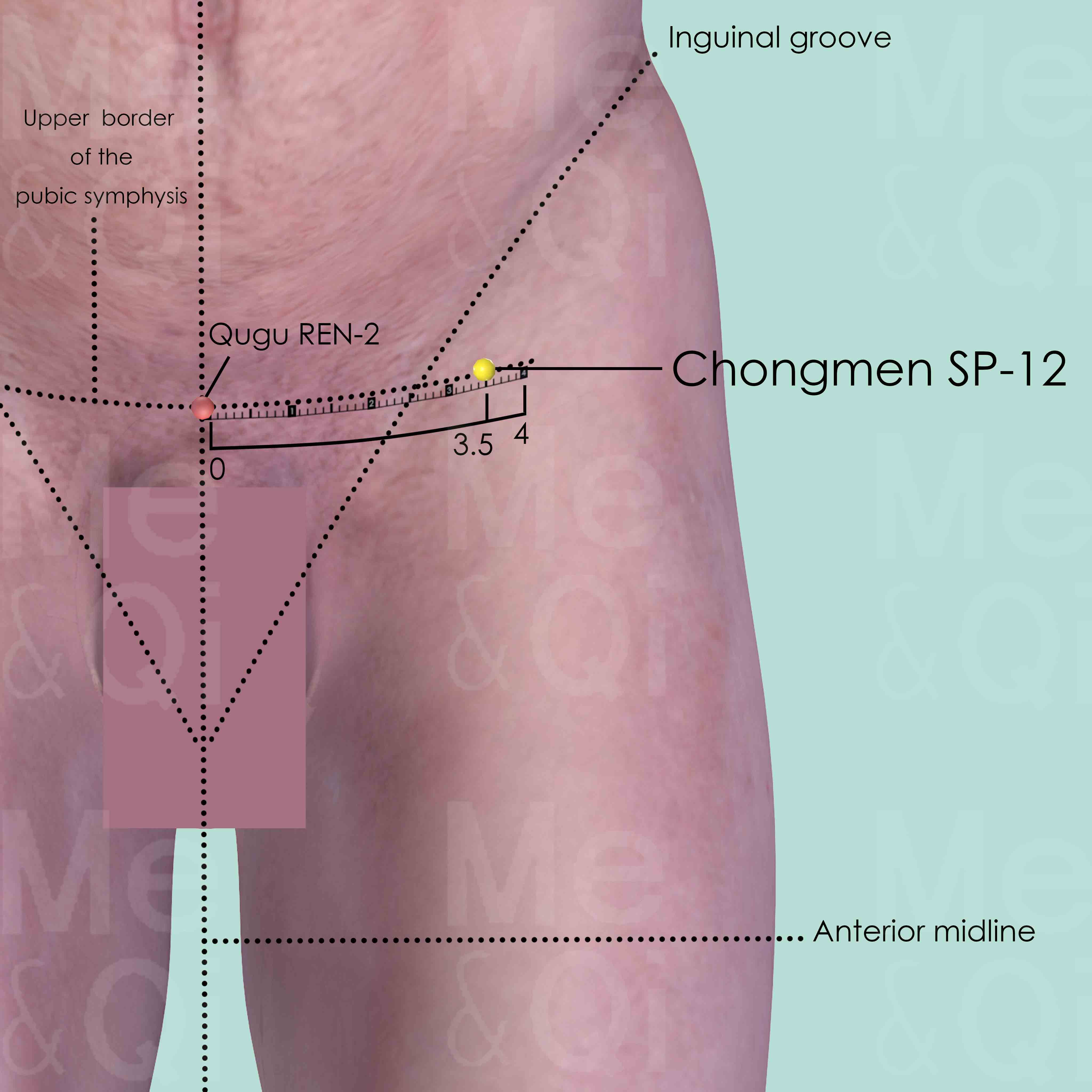
Chongmen SP-12
Lateral to the inguinal groove, on the immediate lateral side of the femoral artery, at the level of the upper border of symphysis pubis, 3.5 cun lateral to Qugu REN-2.
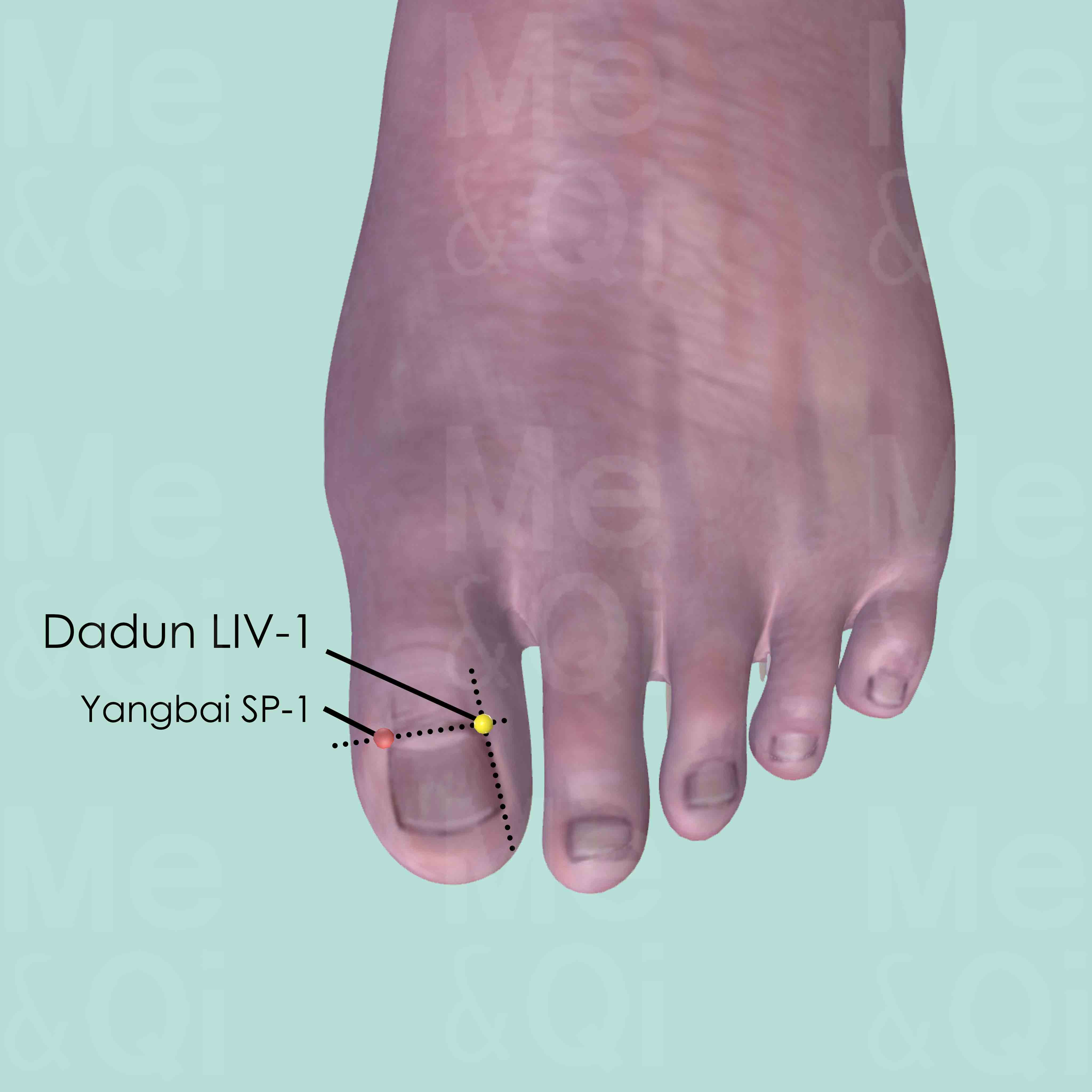
Dadun LIV-1
On the lateral side of the dorsum of the great toe terminal phalanx, between the lateral corner of the nail and interphalangeal joint.
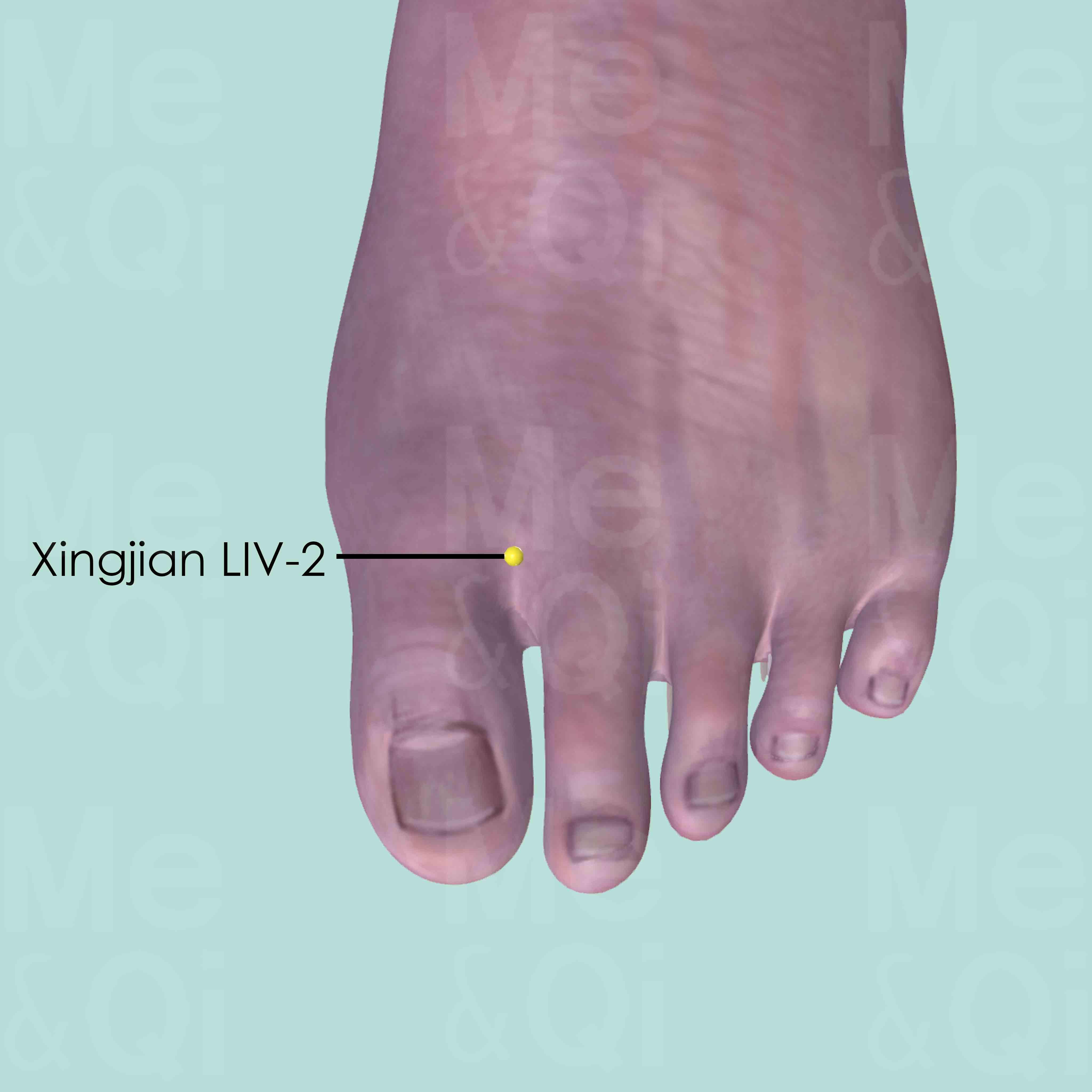
Xingjian LIV-2
Between the first and second toe, on the dorsum of the foot, 0.5 cun proximal to the interdigital fold.
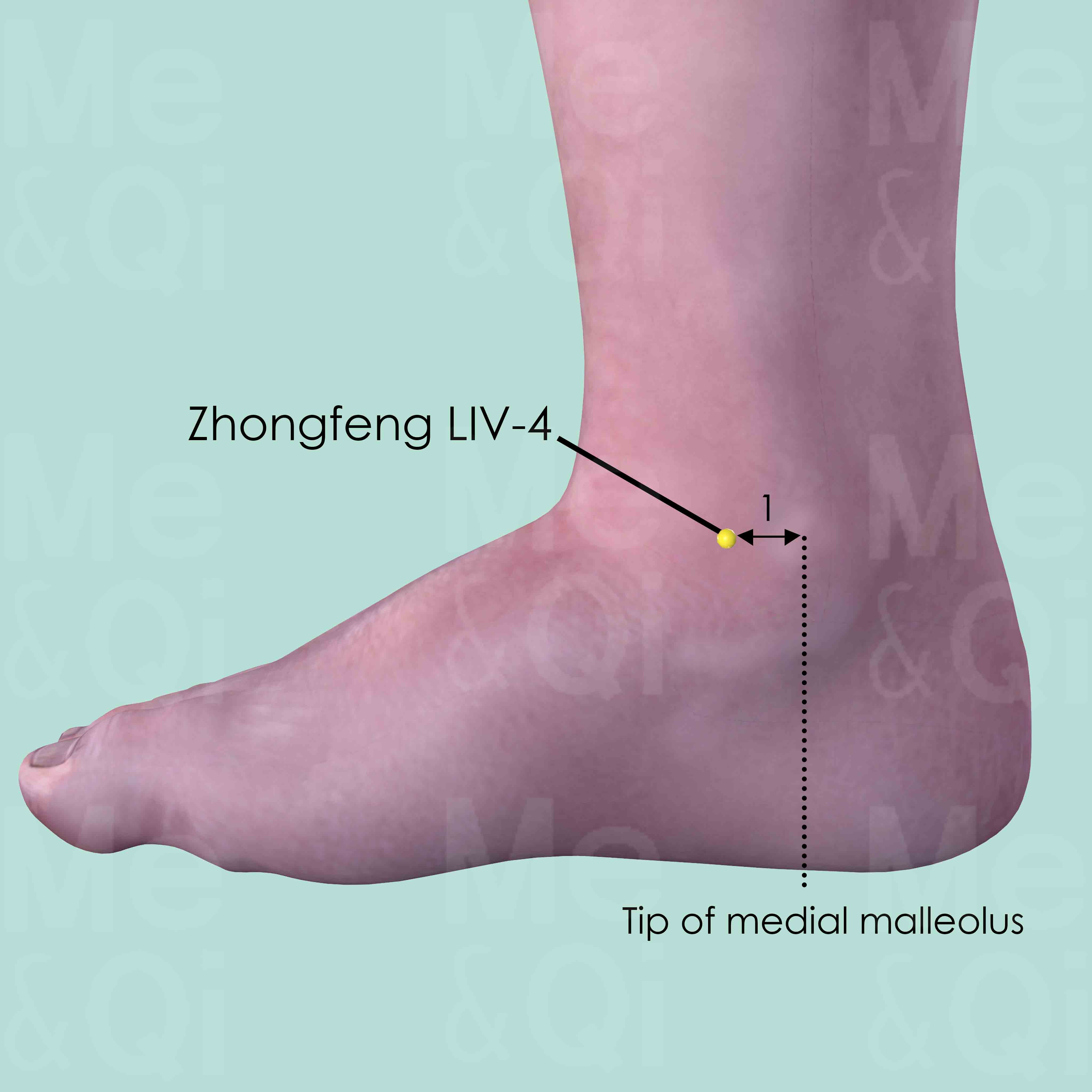
Zhongfeng LIV-4
1 cun anterior to the tip of medial malleolus, in the depression on the medial side of the tendon of the tibialis anterior.
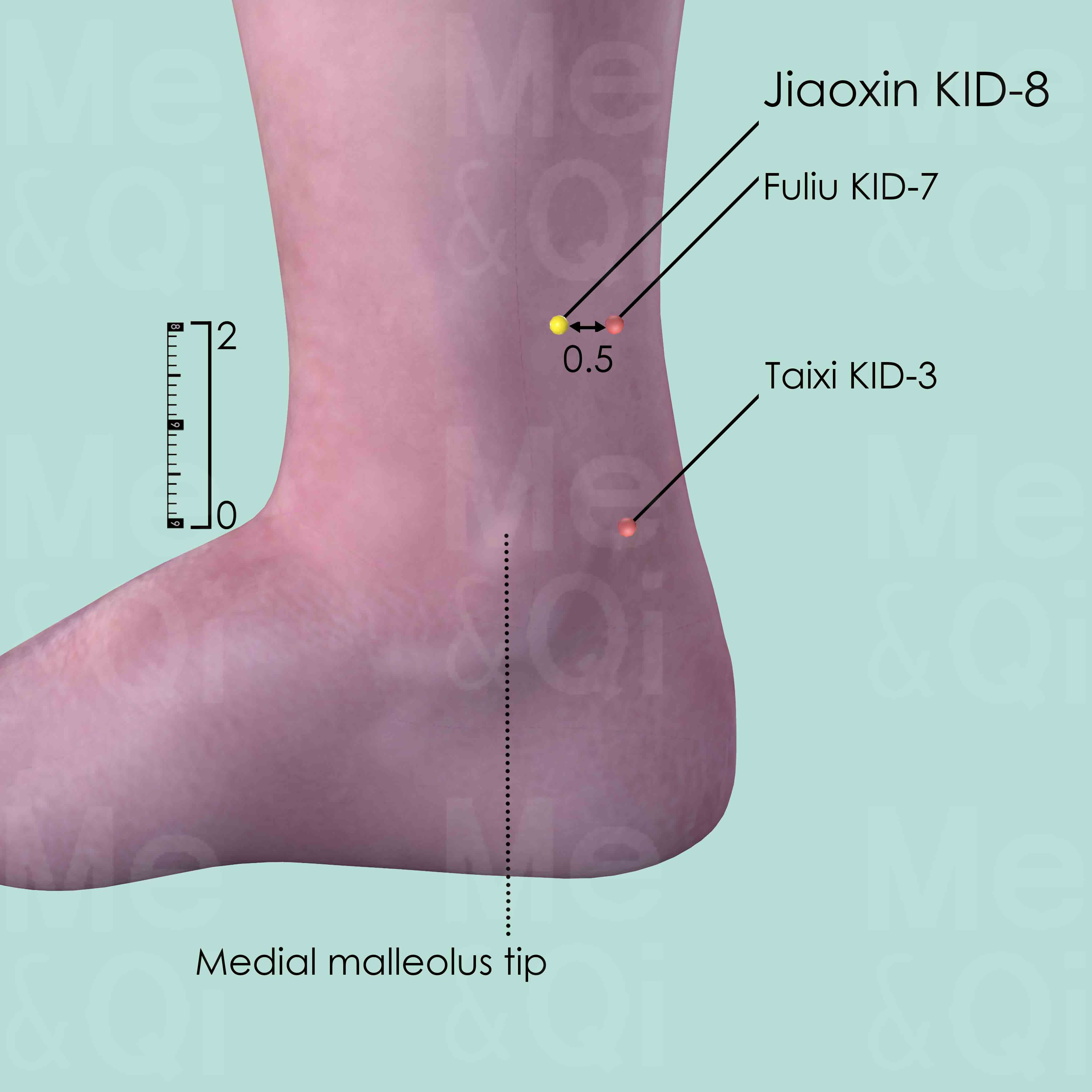
Jiaoxin KID-8
2 cun above Taixi KID-3, 0.5 cun anterior to Fuliu KID-7, posterior to the medial border of tibia.
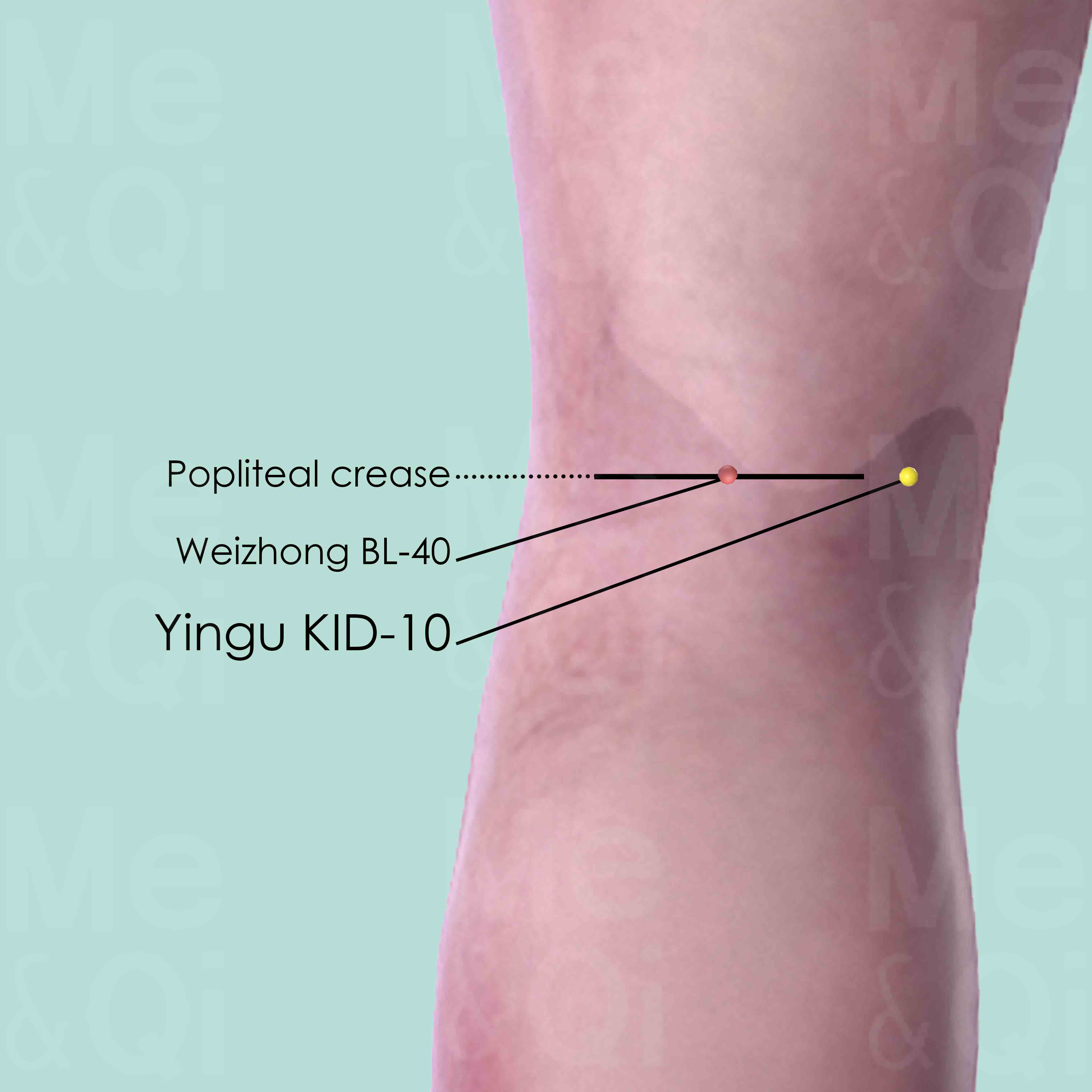
Yingu KID-10
On the medial side of the popliteal fossa, level with Weizhong BL-40, between the tendons of semitendinosus and semimenbranosus muscle when the knee is flexed.
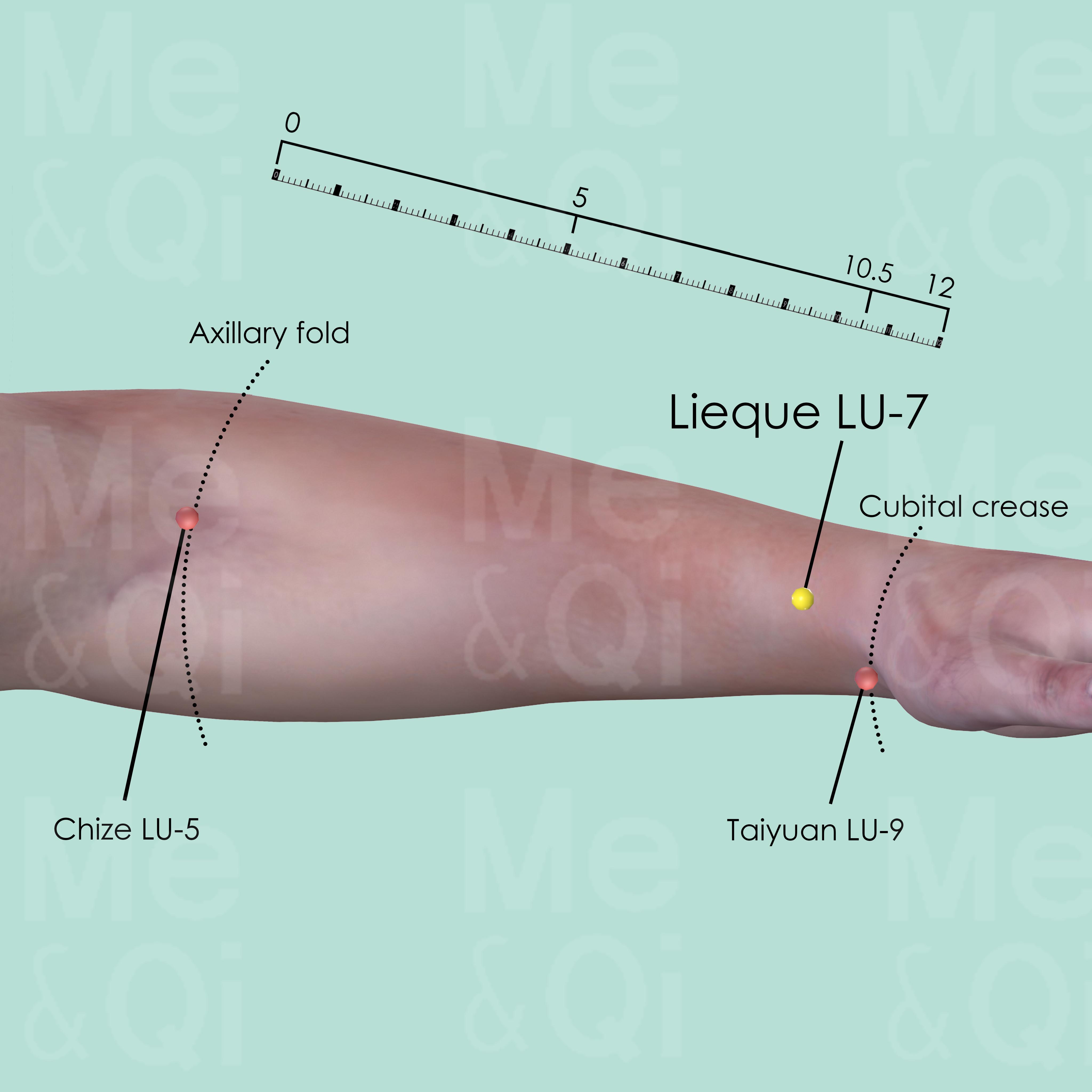
Lieque LU-7
Above the styloid process of the radius, about 1.5 cun proximal to the wrist crease (wrist joint space) in a V-shaped depression.

